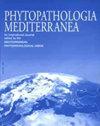Detection and phylogeny of viruses in native Albanian olive varieties
IF 1.9
3区 农林科学
Q2 AGRONOMY
引用次数: 2
Abstract
Forty samples representing 14 native Albanian and two foreign olive varieties were collected from an olive varietal collection plot in the Valias region (Tirana, Albania). The samples were assayed by RT-PCR for presence of olive-infecting viruses, including arabis mosaic virus (ArMV), cherry leaf roll virus (CLRV), cucumber mosaic virus (CMV), olive latent ringspot virus (OLRSV), olive latent virus 1 (OLV-1), olive leaf yellowing-associated virus (OLYaV), strawberry latent ringspot virus (SLRSV) and by PCR for the bacterium Xylella fastidiosa (Xf). Ninety-eight percent of the samples were infected with at least one virus. OLYaV was the most prevalent (85% of samples), followed by OLV-1 (50%), OLRSV (48%), CMV (28%), SLRSV (3%) and CLRV (5%), whereas ArMV and Xf were absent. Fifty-five percent of the samples were infected with one virus, 13% with two viruses, 20% with three, and 5% with four. Analyses of the nucleotide sequences of the Albanian virus isolates generally showed low genetic variability, and that most were phylogenetically related to Mediterranean isolates, in particular to those from Greece and Italy. Five olive trees, representing three native cultivars (‘Managiel’, ‘Kalinjot’ and ‘Kushan-Preze’) and one foreign (‘Leccino’), were found to be plants of the Conformitas Agraria Communitatis (“CAC”) category i.e. free of ArMV, CLRV, SLRSV and OLYaV. Only one tree of the native cultivar ‘Ulliri i kuq’ was free of all tested viruses, so this is plant material of the “Virus-tested” category. Olives derived from both categories could be used for propagation of standard quality plant materiel in a future certification programme for olive in Albania. This is the first report of CLRV, OLRSV, CMV and OLV-1 in Albania. The study also reveals the precarious health status of native olive varieties in the Valias varietal collection plot. However, the discovery of six plants representing two certifiable categories is a first step in a future olive tree certification program in the country.阿尔巴尼亚橄榄品种病毒的检测与系统发育
从瓦利亚斯地区(阿尔巴尼亚地拉那)的一个橄榄品种采集区采集了40个样本,代表14个阿尔巴尼亚本土橄榄品种和两个外国橄榄品种。通过RT-PCR检测样品中是否存在橄榄感染病毒,包括阿拉伯花叶病毒(ArMV)、樱桃叶卷病毒(CLRV)、黄瓜花叶病毒(CMV)、橄榄潜伏环斑病毒(OLRSV)、橄榄潜在病毒1(OLV-1)、油橄榄叶黄变相关病毒(OLYaV)、草莓潜伏环斑毒株(SLRSV),并通过PCR检测细菌法氏木霉菌(Xf)。98%的样本至少感染了一种病毒。OLYaV最普遍(85%的样本),其次是OLV-1(50%)、OLRSV(48%)、CMV(28%)、SLRSV(3%)和CLRV(5%),而ArMV和Xf不存在。55%的样本感染了一种病毒,13%感染了两种病毒,20%感染了三种病毒,5%感染了四种病毒。阿尔巴尼亚病毒分离株的核苷酸序列分析通常显示出较低的遗传变异性,并且大多数与地中海分离株,特别是来自希腊和意大利的分离株在系统发育上有关。五棵橄榄树,代表三个本地品种(“Managiel”、“Kalinjot”和“Kushan Preze”)和一个外国品种(“Leccino”),被发现是Conformitas Agraria Communictatis(“CAC”)类别的植物,即不含ArMV、CLRV、SLRSV和OLYaV。只有一棵本土品种“Ulliri i kuq”的树没有所有测试过的病毒,因此这是“病毒测试”类别的植物材料。在阿尔巴尼亚未来的橄榄认证计划中,这两类橄榄可用于推广标准质量的植物材料。这是阿尔巴尼亚首次报道CLRV、OLRSV、CMV和OLV-1。这项研究还揭示了瓦利亚斯品种采集区本地橄榄品种的不稳定健康状况。然而,代表两个可认证类别的六种植物的发现是该国未来橄榄树认证计划的第一步。
本文章由计算机程序翻译,如有差异,请以英文原文为准。
求助全文
约1分钟内获得全文
求助全文
来源期刊

Phytopathologia Mediterranea
生物-植物科学
CiteScore
4.40
自引率
8.30%
发文量
28
审稿时长
6-12 weeks
期刊介绍:
Phytopathologia Mediterranea is an international journal edited by the Mediterranean Phytopathological Union. The journal’s mission is the promotion of plant health for Mediterranean crops, climate and regions, safe food production, and the transfer of new knowledge on plant diseases and their sustainable management.
The journal deals with all areas of plant pathology, including etiology, epidemiology, disease control, biochemical and physiological aspects, and utilization of molecular technologies. All types of plant pathogens are covered, including fungi, oomycetes, nematodes, protozoa, bacteria, phytoplasmas, viruses, and viroids. The journal also gives a special attention to research on mycotoxins, biological and integrated management of plant diseases, and the use of natural substances in disease and weed control. The journal focuses on pathology of Mediterranean crops grown throughout the world.
The Editorial Board of Phytopathologia Mediterranea has recently been reorganised, under two Editors-in-Chief and with an increased number of editors.
 求助内容:
求助内容: 应助结果提醒方式:
应助结果提醒方式:


